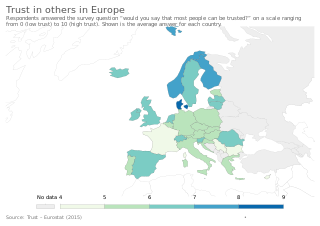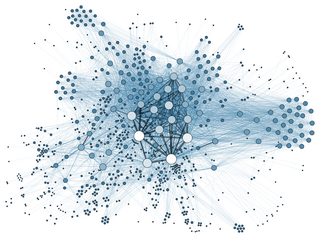
In sociology, socialization or socialisation is the process of internalizing the norms and ideologies of society. Socialization encompasses both learning and teaching and is thus "the means by which social and cultural continuity are attained".

Social norms are shared standards of acceptable behavior by groups. Social norms can both be informal understandings that govern the behavior of members of a society, as well as be codified into rules and laws. Social normative influences or social norms, are deemed to be powerful drivers of human behavioural changes and well organized and incorporated by major theories which explain human behaviour. Institutions are composed of multiple norms. Norms are shared social beliefs about behavior; thus, they are distinct from "ideas", "attitudes", and "values", which can be held privately, and which do not necessarily concern behavior. Norms are contingent on context, social group, and historical circumstances.

A moral panic is a widespread feeling of fear, often an irrational one, that some evil person or thing threatens the values, interests, or well-being of a community or society. It is "the process of arousing social concern over an issue", usually perpetuated by moral entrepreneurs and the mass media, and exacerbated by politicians and lawmakers.
Persuasive technology is broadly defined as technology that is designed to change attitudes or behaviors of the users through persuasion and social influence, but not necessarily through coercion. Such technologies are regularly used in sales, diplomacy, politics, religion, military training, public health, and management, and may potentially be used in any area of human-human or human-computer interaction. Most self-identified persuasive technology research focuses on interactive, computational technologies, including desktop computers, Internet services, video games, and mobile devices, but this incorporates and builds on the results, theories, and methods of experimental psychology, rhetoric, and human-computer interaction. The design of persuasive technologies can be seen as a particular case of design with intent.

Social status is the level of social value a person is considered to possess. More specifically, it refers to the relative level of respect, honour, assumed competence, and deference accorded to people, groups, and organizations in a society. Status is based in widely shared beliefs about who members of a society think holds comparatively more or less social value, in other words, who they believe is better in terms of competence or moral traits. Status is determined by the possession of various characteristics culturally believed to indicate superiority or inferiority. As such, people use status hierarchies to allocate resources, leadership positions, and other forms of power. In doing so, these shared cultural beliefs make unequal distributions of resources and power appear natural and fair, supporting systems of social stratification. Status hierarchies appear to be universal across human societies, affording valued benefits to those who occupy the higher rungs, such as better health, social approval, resources, influence, and freedom.

Institutions are humanly devised structures of rules and norms that shape and constrain individual behavior. All definitions of institutions generally entail that there is a level of persistence and continuity. Laws, rules, social conventions and norms are all examples of institutions. Institutions vary in their level of formality and informality.

Trust is the willingness of one party to become vulnerable to another party on the presumption that the trustee will act in ways that benefit the trustor. In addition, the trustor does not have control over the actions of the trustee. Scholars distinguish between generalized trust, which is the extension of trust to a relatively large circle of unfamiliar others, and particularized trust, which is contingent on a specific situation or a specific relationship.

Diffusion of innovations is a theory that seeks to explain how, why, and at what rate new ideas and technology spread. Everett Rogers, a professor of communication studies, popularized the theory in his book Diffusion of Innovations; the book was first published in 1962, and is now in its fifth edition (2003). Rogers argues that diffusion is the process by which an innovation is communicated over time among the participants in a social system. The origins of the diffusion of innovations theory are varied and span multiple disciplines.

Sociobiology: The New Synthesis is a book by the biologist E. O. Wilson. It helped start the sociobiology debate, one of the great scientific controversies in biology of the 20th century and part of the wider debate about evolutionary psychology and the modern synthesis of evolutionary biology. Wilson popularized the term "sociobiology" as an attempt to explain the evolutionary mechanics behind social behaviour such as altruism, aggression, and the nurturing of the young. It formed a position within the long-running nature versus nurture debate. The fundamental principle guiding sociobiology is that an organism's evolutionary success is measured by the extent to which its genes are represented in the next generation.

Homophily is a concept in sociology describing the tendency of individuals to associate and bond with similar others, as in the proverb "birds of a feather flock together". The presence of homophily has been discovered in a vast array of network studies: over 100 studies have observed homophily in some form or another, and they establish that similarity is associated with connection. The categories on which homophily occurs include age, gender, class, and organizational role.
Xenocentrism is the preference for the cultural practices of other cultures and societies, such as how they live and what they eat, rather than of one's own social way of life. One example is the romanticization of the noble savage in the 18th-century primitivism movement in European art, philosophy and ethnography. Xenocentrism contrasts with ethnocentrism, the perceived superiority of one's own society to others.

A sociological theory is a supposition that intends to consider, analyze, and/or explain objects of social reality from a sociological perspective, drawing connections between individual concepts in order to organize and substantiate sociological knowledge. Hence, such knowledge is composed of complex theoretical frameworks and methodology.
In gender studies, hegemonic masculinity is part of R. W. Connell's gender order theory, which recognizes multiple masculinities that vary across time, society, culture, and the individual. Hegemonic masculinity is defined as a practice that legitimizes men's dominant position in society and justifies the subordination of the common male population and women, and other marginalized ways of being a man. Conceptually, hegemonic masculinity proposes to explain how and why men maintain dominant social roles over women, and other gender identities, which are perceived as "feminine" in a given society.

Cutamesine (SA 4503) is a synthetic sigma receptor agonist which is selective for the σ1 receptor, a chaperone protein mainly found in the endoplasmic reticulum of cells in the central nervous system. These σ1 receptors play a key role in the modulation of Ca2+ release and apoptosis. Cutamesine's activation of the σ1 receptor is tied to a variety of physiological phenomena in the CNS, including activation of dopamine-releasing neurons and repression of the MAPK/ERK pathway.
Janet Lippman Abu-Lughod was an American sociologist who made major contributions to world-systems theory and urban sociology.
The unified theory of acceptance and use of technology (UTAUT) is a technology acceptance model formulated by Venkatesh and others in "User acceptance of information technology: Toward a unified view". The UTAUT aims to explain user intentions to use an information system and subsequent usage behavior. The theory holds that there are four key constructs: 1) performance expectancy, 2) effort expectancy, 3) social influence, and 4) enabling conditions.
Hypocrisy is the practice of engaging in the same behavior or activity for which one criticizes another or the practice of claiming to have moral standards or beliefs to which one's own behavior does not conform. In moral psychology, it is the failure to follow one's own expressed moral rules and principles. According to British political philosopher David Runciman, "Other kinds of hypocritical deception include claims to knowledge that one lacks, claims to a consistency that one cannot sustain, claims to a loyalty that one does not possess, claims to an identity that one does not hold". American political journalist Michael Gerson says that political hypocrisy is "the conscious use of a mask to fool the public and gain political benefit".

Social contagion involves behaviour, emotions, or conditions spreading spontaneously through a group or network. The phenomenon has been discussed by social scientists since the late 19th century, although much work on the subject was based on unclear or even contradictory conceptions of what social contagion is, so exact definitions vary. Some scholars include the unplanned spread of ideas through a population as social contagion, though others prefer to class that as memetics. Generally social contagion is understood to be separate from the collective behaviour which results from a direct attempt to exert social influence.
Value sensitive design (VSD) is a theoretically grounded approach to the design of technology that accounts for human values in a principled and comprehensive manner. VSD originated within the field of information systems design and human-computer interaction to address design issues within the fields by emphasizing the ethical values of direct and indirect stakeholders. It was developed by Batya Friedman and Peter Kahn at the University of Washington starting in the late 1980s and early 1990s. Later, in 2019, Batya Friedman and David Hendry wrote a book on this topic called "Value Sensitive Design: Shaping Technology with Moral Imagination". Value Sensitive Design takes human values into account in a well-defined matter throughout the whole process. Designs are developed using an investigation consisting of three phases: conceptual, empirical and technological. These investigations are intended to be iterative, allowing the designer to modify the design continuously.

Michael Hechter is an American sociologist and Foundation Professor of Political Science at Arizona State University. He is also Emeritus Professor of Sociology at the University of Washington.








